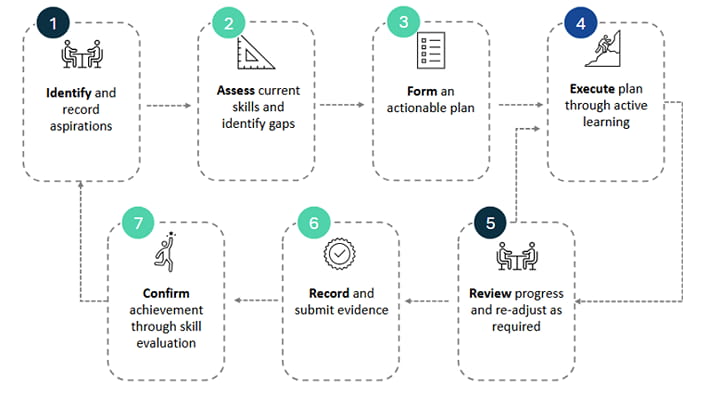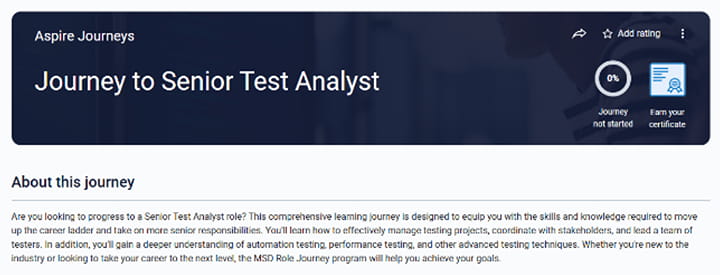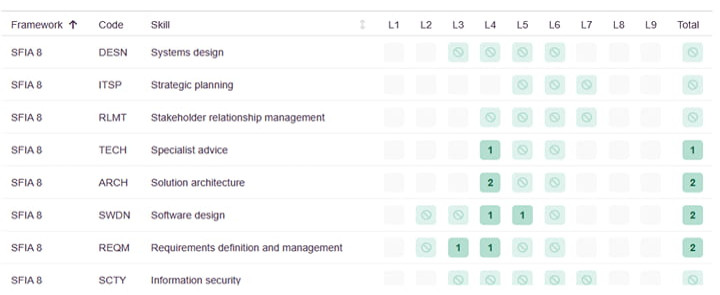Case studies: tools to support SFIA alignment
How government agencies are using Skills Framework for the Information Age (SFIA) alignment for their digital workforce.
SFIA 9 alignment with position descriptions and learning pathways — Ministry of Social Development
Ministry of Social Development’s (MSD) practice leaders have invested considerable effort in creating consistent practice structures across analysis and design, software engineering and quality assurance technology practice areas.
MSD used SFIA skills and core competencies to define 4 seniority levels within each practice ranging from associate to lead levels. Using SFIA to define these roles helped ensure consistent position descriptions for each seniority level. They also supported the design of learning pathways as part of MSD’s learning and development framework.
This approach has meant that MSD has been able to consistently baseline relevant skills for each practice member, document aspirations and growth areas, design skill-based learning plans, execute them and document progress.

Detailed description of the image
A 7-stage cycle for integrating the Skills Framework for the Information Age (SFIA) into the learning and development process within MSD.
A cyclical and iterative approach, each stage flows to the next stage, with stage 7 flowing into stage 1. At stage 5 the process can also flow back to stage 4. The 7 stages are:
- Identify and record aspirations
- Assess current skills and identify gaps
- Form an actionable plan
- Execute plan through active learning
- Review progress and re-adjust as required
- Record and submit evidence
- Confirm achievement through skill evaluation.
SFIA aligned learning resources — Ministry of Social Development
MSD has designed their learning and development framework for technology practice members around SFIA. The framework includes creating skill-based learning and development plans and managing them through successful execution. The plans rely on a number of SFIA-aligned tools.
These tools allow MSD to assess the current skill levels of staff members and transform career aspirations into clear action plans linked to specific skills. Most upskilling needs are then addressed through a combination of learning resources available on digital learning platforms and on-the-job learning.
MSD worked with digital learning platform consultants to configure collections of learning resources relevant to specific skills and learning paths. This enables their people leaders to effectively support staff members in their continuous learning efforts and offer learning support relevant to staff members’ goals and skills.

Detailed description of the image
Journey to Senior Test Analyst
About this journey
Are you looking to progress to a Senior Test Analyst role? This comprehensive learning journey is designed to equip you with the skills and knowledge required to move up the career ladder and take on more senior responsibilities. You’ll learn how to effectively manage testing projects, coordinate with stakeholders, and lead a team of testers. In addition, you’ll gain a deeper understanding of automation testing, performance testing, and other advanced testing techniques. Whether you’re new to the industry of looking to take your career to the next level, the MSD Role Journey program will help you achieve your goals.

Detailed description of the image
Flowchart showing the 7 stages and what framework is used at each stage.
The process is cyclic with each stage flowing to next, with stage 7 flowing back to stage 1. At stage 5 the process can flow back to stage 4. The 7 stages and the framework are:
- Identify and record aspirations
- Assess current skills and identify gaps
- Form an actionable plan
- Execute plan through active learning
- Review progress and re-adjust as required
- Record and submit evidence
- Confirm achievement through skill evaluation.
SFIA digital capability uplift — Ministry for the Environment
In , the Ministry for the Environment (MfE) profiled their staff and identified skills gaps. From the SFIA framework, they had a list of the SFIA skills and associated activities for each function. This was indexed to their service catalogue and enabled them to map service demand through to individual SFIA skills.
Using tools to identify skills gaps
MfE reviewed a number of tools in the skill management space before agreeing on one. They used the tool to profile staff skills against the skill required for their current, and ideally next role.
This enabled them to identify where the team lacked a particular skill or who else might have that skill. This approach helped to identify key-person risks, areas for individual or group training and development, and allocating responsibilities and services across multiple kaimahi (staff), and vice versa, where needed.
The benefits for kaimahi
The goal was (and is still) not to penalise people for lacking a skill, but to make sure that the wider team has the skills required to deliver the services demanded of it. MfE uses identified skills gaps to inform development plans for kaimahi and hiring decisions. At the same time, kaimahi can see exactly how each skill tracks to MfE’s services and strategic and group objectives.
By scoring themselves against both their current and desired roles, and having an active moderation conversation, people leaders and kaimahi can identify exactly what development they need to deliver excellence in their current role as well as to prepare for their next.
This clarity is greatly valued by kaimahi, and is a key strength of this approach.

Detailed description of the image
A table showing the skills gaps at each level of responsibility.
The table has a column with the 8 skills:
- System design
- Strategic software design
- Stakeholder relationship management
- Specialist advice
- Solution architecture
- Software design
- Requirements definition and management
- Information security
There is a column for each of the 9 levels of responsibility. The gap for each skill and responsibility level is represented in the table.

